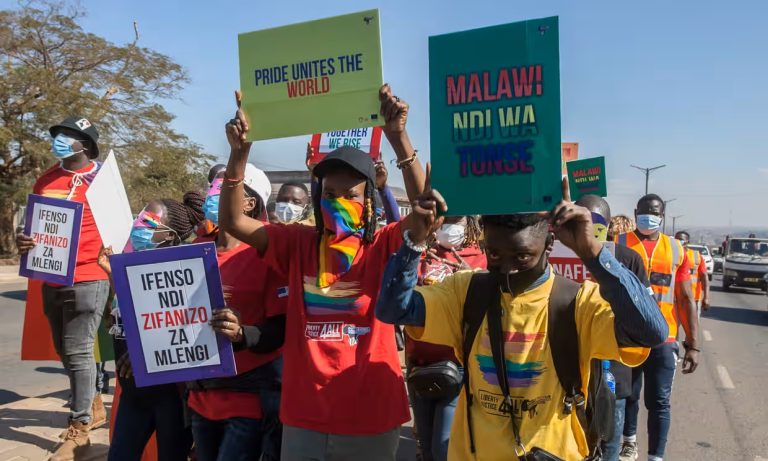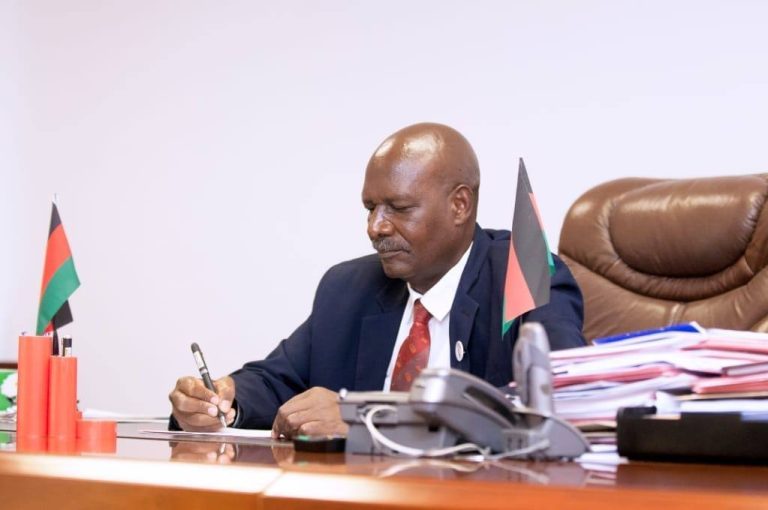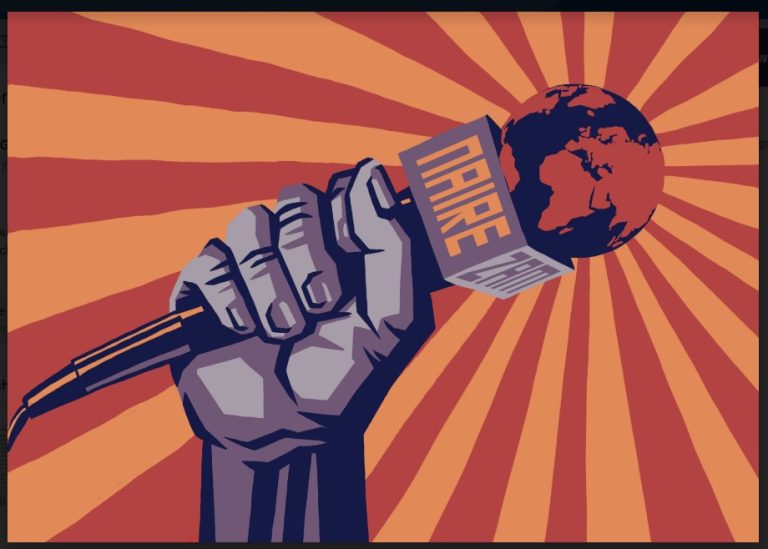By Mzati Nkolokosa
Over 7 000 Malawians, mostly women and children, in the deep rural area of Nyachikadza, in the Southern tip of Malawi’s border with Mozambique, have lived for 24 years without health and educational services following government’s withdrawal of civil servants and closure of services after flooding.
The government apparently terminated government services to force the inhabitants to move, described as “a serious violation of human rights”. Besides, a law scholar in the University of Malawi, Dr Lewis Bande, has said people of Nyachikadza “can sue the government for various violations of human rights.”

Nyachikadza, located 40 km south of Nsanje boma, is an isolated area sandwiched between Shire River on Malawi’s eastern border with Mozambique and the Ndindi Marsh on the west.
Because of its geographical location, it is flooded every year. The floods are mostly not life-threatening, but in bad years they force many people from their homes.
Former president Bakili Muluzi declared Nsanje and Chikwawa a disaster area in February 1997, after a week of heavy rains and flooding that displaced an estimated 80 000 Malawians and 20 000 Mozambicans according to the Nsanje District Council.
Immediately after the 1997 floods, the district council withdrew civil servants. It closed schools and health centres “to force people to move out of Nyachikadza because the area is no longer suitable for settlement,” according to Traditional Authority Nyachikadza.

The government closed five primary schools—Nyamalikombe, Thuka, Nyankholokolo, Kasume and Nansongole—and the government transferred teachers out of the area.
Twenty-four years later, the people of Nyachikadza have not moved.
The Nsanje District Health Office provided mobile clinics until 2015, another year of serious flooding. The clinics were stopped, apparently in another attempt to persuade people to move. Six years later, Nyachikadza’s population is growing.
“Despite the prohibition on the provision of social services since 1997, the community members have remained in Nyachikadza,” said Donald Makoka of Centre for Agricultural Research and Development (CARD) at the Lilongwe University of Agriculture and Natural Resources (LUANAR), in a 2017 paper.
The ban, he added, “has had a serious impact on access to essential social services, a serious human rights violation”.
Crimes against humanity
Article 7 of the Rome Statute of the International Criminal Court considers the “deportation or forcible transfer of population” a crime against humanity.
“The declaration of a state of disaster over an area is no justification for denying people their constitutional rights to education, health care and other public services,” said Dr Lewis Bande, a senior lecturer in the law faculty of the University of Malawi.
Bande said he was baffled that the government is using a disaster declaration made decades ago to deprive citizens of access to public services.
“A declaration of a state of disaster can remain in force for the initial maximum period of three months,” said Bande. “The President may extend the period of the state of disaster, but not for more than three months. The extension must also be gazetted.”
Life in Hell

Interviews with people in Kazingizi, about seven kilometres from Nyachikadza, highlighted the difficulties people face when it rains and the marsh becomes what is known as “the lake.”
A canoe has to make its way through reed beds to reach Nyachikadza from Kazingizi. “The journey takes more than two hours,” a group of young fishermen told the Platform for Investigative Journalism/Michiru Digest.
The Mphukira and Ndonyo group of villages in Nyachikadza walk 25 kilometres to a health centre in the Ndamera Traditional Authority. In contrast, those from Guta and Tchapo villages seek health services in Mbenje, a considerable distance away.
As a result, some women give birth at home without any medical attention during their pregnancy.
Community members have reopened some schools which offer classes up to Std 5 and have recruited volunteer teachers.
To attend senior primary school, children have to leave Nyachikadza and live in rented accommodation, often without parents, in the Ndamera Traditional Authority.
Those who cannot make this arrangement are often forced to drop out of school. Consequently, child marriages are higher at Nyachikadza than in most parts of Malawi.
There are no NGOs at Nyachikadza and no outside interventions of any kind, not even on Covid-19.
Radio signals from Malawi are rare, although people can pick up signals from Mozambique. There is no mobile phone network. Some areas have an unreliable spill-over network.

Despite being neglected by the government, the people of Nyachikadza pay VAT whenever they buy goods and services from upland areas.
History of Nyachikadza
The inhabitants of Nyachikadza originated from the Kamanga Traditional Authority in Mozambique and arrived in Malawi in the 1880s, according to the Nyachikadza Traditional Authority. “The place was habitable,” he said. “There were no serious floods until … 1979. In some parts of Nyachikadza, the water lasted for four years.”
The next floods were in 1989 and eight years later in 1997, when Nyachikadza was declared a disaster area.
The traditional authority said Muluzi made the declaration verbally and used no document to declare the area unsuitable for settlement. He conveyed the message through the withdrawal of services.
Searching for 1997 disaster declaration documents at Nsanje District Council and the Department of Disaster Management in Lilongwe proved fruitless.
In the absence of documentation, said the traditional authority, there was no legally binding declaration.
“That is correct,” said Bande. “At the moment, there is no legally valid declaration of a state of disaster regarding the Nyachikadza area.”
According to the Disaster Preparedness of Relief Act of 1991, “a declaration must be in writing and must be gazetted”.
Culprits
All levels of government are complicit in what appear to be human rights violations, including the national ministries of health, education and social welfare; the District Commissioner’s office; Nsanje MPs, especially from the Nsanje South constituency; and since the 2001 local government elections, Nsanje ward councillors.
The NGO community in Nsanje also failed to stand with the people of Nyachikadza.
Floods ‘a blessing’
For generations, the people of Nsanje and Chikwawa have thrived by cultivating and fishing on flooded land along the Shire River.
They regard floods as a blessing. “The land at Nyachikadza is so fertile that people do not use fertilisers,” said Dr Makoka in an interview, saying that silt brought by flooding accounted for the soil’s fertility.

“People of Nyachikadza live on floods,” said Chilaka Zuwawo, a resident of the area, in an interview at Marka.
Nyachikadza has been Nsanje’s breadbasket, feeding the district and beyond. Some rice and sweet potatoes from the area are sold in Blantyre and parts of the southern region.
Nyachikadza also supplies fish, especially makakana, to the southern region, especially the urban centres of Nsanje, Chikwawa and Blantyre.
“The marsh is our gold,” said one resident. “We would starve to death if we moved away from the lake. There are no factories here to employ us. We live on floods.”
Bande said that “a proper balancing and understanding” was needed. “The idea of forcing people out of these areas, without understanding that they depend on them for survival, is retrogressive,” he said.
“One should remember that the people of Egypt have thrived on the flooding of the river Nile. The people of Nyachikadza have demonstrated that it is possible to harness the power of flooding to their advantage.”
Infrastructure damaged

The 1997 floods caused significant damage to infrastructure. The Bangula-Chiromo railway line was damaged, and the bridge at Chiromo was rendered useless.
Close to Fatima, on the eastern side of Nsanje, floods displaced, 340 families. The Ruo River also broke its banks.
Between 1966 and 1989, there was an agricultural research project at Usiyani Village, not far from the confluence of Ruo and Shire, near Fatima. The scheme used water from Ruo for irrigation. Trees and reeds protected the water channels.
When the scheme ended in 1989, the project was vandalised. People cut down trees, and the land was exposed to the speeding waters of the Ruo.
Since 1989 the fast-moving Ruo has made the Shire swell and flood, according to local sources. The sources said the solution was to manage Ruo the same way as when the agricultural scheme was functional.
Chikwawa and Nsanje
Nsanje, the southernmost district of Malawi, covers an area of 1 900 sq. km with a population of 195 000, according to the 2018 census.
In theory, this means there is about 0.01 sq. km for each inhabitant. But the 135 sq. km Mwabvi Game Reserve lies in the north-western part of the district, while the Elephant Marsh is about 400 sq. km in extent depending on the flooding of the Shire and Ruo rivers, and Ndindi Marsh stretches for 150 sq. km.
It receives negligible rains, a mere 750 millimetres annually. The main crops for rain-fed agriculture are millet, sorghum and cotton.
The neighbouring district of Chikwawa, to the north, is about 4 700 sq. km and has a population of 356 000 according to the census.
However, like Nsanje, it is extensively used for public and private economic activities. Majete Game Reserve takes up 700 sq. km while Lengwe, an arid national park without rain, is 900 sq. km.
Illovo Sugar farms occupy vast areas, too, while Chikwawa has several private cattle ranches. These activities leave the population in areas that are not safe from flooding.
The district of Thyolo, the northeast of Nsanje, was mainly grabbed by the former colonial masters, who own vast tea estates.
“So, when we are told to move, where shall we go?” asked Zuwawo. “To Mozambique? Where is the land?”
Suing Government
Dr Bande says people of Nyachikadza can seek relief from the courts because “they have a strong case against the government” on three fronts.
“They can ask the court for various reliefs: first, declaratory reliefs whereby the court declares the government to be violating their rights. This is a relief in its own right and a vindication of their rights, said Dr Bande.
“Secondly, they can ask for court orders compelling the government to provide public services and infrastructures that support and facilitate the enjoyment of their rights, that is, schools for right to education and health facilities for the right to health,” he said.
According to Dr Bande, the third area is that people of Nyachikadza can ask courts for damages, compensation for loss suffered by failure by the government to provide the necessary facilities. “This one is tricky, however, as it may prove difficult to measures the loss actually incurred by these people,” he said.
Does DoDMA have any records of the declaration of the disaster-prone area at Nyachikadza? There was no response from DoDMA after three weeks of follow-ups to a PIJ questionnaire.
However, TA Nyachikadza said he was happy that scholars and the media are paying attention to the plight people suffer under his jurisdiction. “I will do everything possible to get social services back to my area,” he said.







.jpg)


